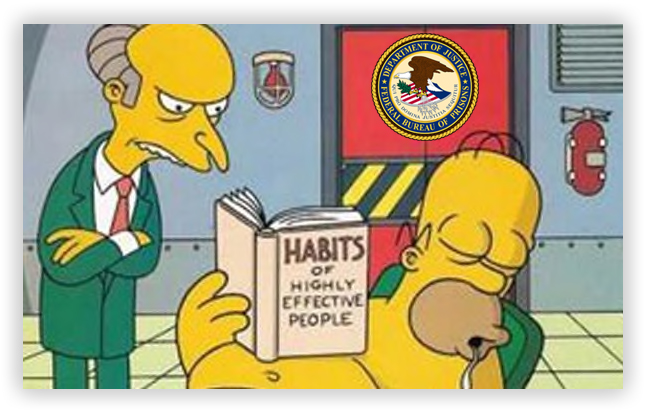We post news and comment on federal criminal justice issues, focused primarily on trial and post-conviction matters, legislative initiatives, and sentencing issues.

WHERE HAVE WE HEARD THIS ONE BEFORE?
Complaints about the BOP healthcare system are as common as kvetching about the food it serves. There may be a reason for that.
 Vincent “Chickie” DeMartino, serving the final 30 months of a 300-month sentence for an attempted mob hit, sought compassionate release under 18 U.S.C. § 3582(c)(1)(A)(i) because of his deteriorating health – in particular, complications with his right eye – and because of the BOP’s “cavalier attitude” in addressing his worsening medical problems.
Vincent “Chickie” DeMartino, serving the final 30 months of a 300-month sentence for an attempted mob hit, sought compassionate release under 18 U.S.C. § 3582(c)(1)(A)(i) because of his deteriorating health – in particular, complications with his right eye – and because of the BOP’s “cavalier attitude” in addressing his worsening medical problems.
Vince argued that his poor health and the BOP’s refusal to do anything about it constituted the “extraordinary and compelling” reasons required by the statute for a reduction of his sentence to time served.
Last week, the United States District Court for the Eastern District of New York agreed. As the Daily News colorfully put it
A Brooklyn judge sprang a violent mobster from prison because he said the federal Bureau of Prisons did a lousy job taking care of the wiseguy’s medical problems.
Federal Court Judge Raymond Dearie issued a scathing ruling Thursday, saying the feds weren’t competently treating made man Vincent “Chickie” DeMartino’s maladies. The goodfella had more than two years left of his 25-year sentence for an attempted hit on a fellow Colombo family member.
The Court found that Vince suffered from high blood pressure which puts him at severe risk of stroke and numerous ophthalmologic issues. Vince said he was essentially blind in his right eye and had 20/400 vision overall, which made him legally blind.
 What made his condition “all the more extraordinary and compelling,” the Court held, was “the BOP’s lack of responsiveness and candor with respect to his medical conditions.” Despite the BOP being aware of the condition, the District Court said, “the record reflects a consistent pattern on the part of the BOP of downplaying Mr. DeMartino’s conditions and delaying treatment. Despite the severity of his ocular conditions, it has been a herculean task for Mr. DeMartino to see an ophthalmologist.”
What made his condition “all the more extraordinary and compelling,” the Court held, was “the BOP’s lack of responsiveness and candor with respect to his medical conditions.” Despite the BOP being aware of the condition, the District Court said, “the record reflects a consistent pattern on the part of the BOP of downplaying Mr. DeMartino’s conditions and delaying treatment. Despite the severity of his ocular conditions, it has been a herculean task for Mr. DeMartino to see an ophthalmologist.”
A month ago, the Court told the parties that Vince required “immediate appropriate care.” The government promised the Court that Vince would see an outside specialist right away. That of course did not happen. Vince’s prior visits to the eye doc had been canceled, according to the BOP, because the facility Health Administrator asserted that the “retina specialist does not need to see the defendant again unless he is having further complications.”
This statement, charitably put, lacked the kind of candor that the government would have demanded from Vince, were the tables turned.. The Court found the statement to be “misleading, as the Health Administrator’s note omitted reference to the ophthalmologist’s recommendation that Mr. DeMartino undergo pars plana vitrectomy surgery.”
When the Court ordered the Government and BOP to provide clarification about Vince’s need for surgery from the same ophthalmologist who had recommended surgery, the Government pulled the old “bait-and-switch.” It provided a memorandum from an optometrist – not an ophthalmologist and definitely not the one who had recommended the surgery – to support the appalling lack of care. The BOP optometrist said Vince’s surgery was unnecessary, but then qualified his opinion by admitting that he could not “directly determine the need, or lack thereof, for surgery” and would need to “defer questioning related to a need for surgery and/or the urgency of surgery to an ophthalmologic surgeon.”
That’s sort of like saying “it’s definitely not going to rain tomorrow, but I have not seen a weather forecast and even if I had, I’m not a meteorologist and I really have no idea whether what I just said is right or not.”
 “All told,” the court ruled, “this record leaves the Court with the impression that the BOP has undertaken the bare minimum of care for Mr. DeMartino, limiting its efforts to ensuring that he does not require emergency surgery, but minimizing the fact that his vision is failing and refusing to implement any meaningful plan to monitor or treat the conditions in the longer term… The BOP is not a common jailor. Theirs is a far more challenging and vital responsibility. Human beings are entrusted to their care for decades on end. There is no excuse for inaction or dissembling and, in this Court’s view, no alternative to immediate release.”
“All told,” the court ruled, “this record leaves the Court with the impression that the BOP has undertaken the bare minimum of care for Mr. DeMartino, limiting its efforts to ensuring that he does not require emergency surgery, but minimizing the fact that his vision is failing and refusing to implement any meaningful plan to monitor or treat the conditions in the longer term… The BOP is not a common jailor. Theirs is a far more challenging and vital responsibility. Human beings are entrusted to their care for decades on end. There is no excuse for inaction or dissembling and, in this Court’s view, no alternative to immediate release.”
Order (ECF 276), United States v. DeMartino, Case No 1:03cr265 (EDNY, May 26, 2022)
– Thomas L. Root


























